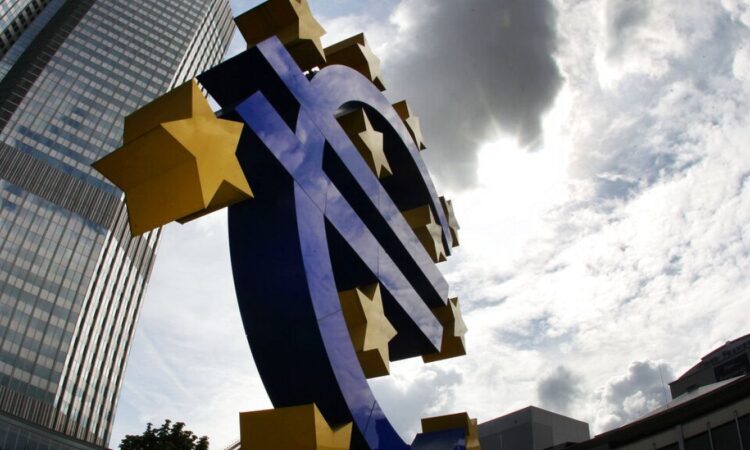
Uncertainty over sluggish productivity and high labour costs could draw back the economic output of the eurozone, global credit rating agency S&P said in its updated economic outlook.
The eurozone is facing weaker-than-expected growth prospects over the next two years and inflation may recede as rapidly as many would hope, leading to fewer rate cuts from the European Central Bank (ECB), suggests the latest economic forecast from global credit rating agency S&P.
The bloc is going to have 0.7% GDP growth this year, slightly lower than the 0.8% in the previous forecast by S&P Global Ratings.
There are doubts that the rebound in growth will be strong after 2024, partially because of alarmingly low productivity, which has an impact on economic output, employment and wages.
“The European economy is on track for improvement in activity and some moderation in employment growth, but what we see also is that productivity has fallen behind its long-term trends,” Sylvain Broyer, S&P’s chief EMEA economist, said to Euronews Business, adding that productivity has been practically flat for years now, which is quite concerning.
Meanwhile, the implementation of the Next Generation EU recovery plan, aiming to foster the green and digital transition through public investment and reforms, is falling way behind schedule. This means a lot of public spending is missing from the eurozone economy.
Projects that were not completed by their deadline by the third quarter of 2023 represent a gap of €127 billion, an equivalent of 0.7% of 2023 EU GDP, which has yet to be spent and boost the economy.
“Both the stagnating productivity and the delay in the implementation of Next Generation EU have led us to revise down the expected rebound in growth for 2025 and 2026.”
The agency’s latest forecast for eurozone GDP is that it will grow by 1.3% in 2025 and 2026, instead of the previously expected 1.5% and 1.4% respectively.
ECB rate cuts are on the way, with risks in inflation
Looking at the current surprisingly low consumer price growth led the credit rating agency to lower its inflation forecast to 2.6% from 2.9% for 2024.
However, in the longer term, there is a risk that high wage growth, around 4% now, coupled with sluggish productivity could drive inflation up, which could also be affected by international trade in the Red Sea.
Although, as wage growth is expected to remain high, coupled with sluggish productivity and developments in international trade, it has pushed expected inflation slightly upwards to 2.1% from 2.0% for 2025, and to 1.9% from 1.7% for 2026.
Broyer said that the ECB is going to cut rates three times in 2024, starting in June. In 2025, the ECB would potentially see fewer rate cuts than previously expected, only three, leading the deposit facility rate, currently 4%, to finish 2025 at 2.5%.
The German economy is exiting recession
According to the report, Europe’s biggest economy is going to see 0.3% GDP growth this year, as it is exiting recession slowly.
Broyer said that more and more data suggests that the German manufacturing sector has left behind its period of contraction at the start of the year and there are promising signs in the chemical sector, for instance, that production is picking up.
“For Germany, it is not a question about the short-term rebound. It’s underway. The question is really about the medium-term prospects,” the chief economist said, warning that the country’s working population is fast shrinking.
Germany, as well as the whole bloc, is facing this challenge. The lowering working-age population is likely to reduce GDP growth by 0.5%-0.6% per year over the next five years, according to the report, which cited figures from the United Nations Department of Economic and Social Affairs. However, in Europe, immigration, following the war in Ukraine, could reverse this effect somewhat, Broyer added.
“Another question is about the competitiveness of the German economy after this huge energy price shock, and also in the context of China, challenging Germany, more than ever,” Broyer said. “China is competing directly in the automotive sector and the chemical sector.”
Major risks ahead of the Eurozone economies
For the next 12-18 months, geopolitics are playing a serious role in the prospects of the bloc. “We have the two regional conflicts, shaking the continent with no end in sight, and will have key elections this year, in the US and Europe both having the potential to change trade,” Broyer also noted and added that the European economy, as well as the German economy, are highly reliant on trade.
Another significant risk relates to inflation. “So inflation could recede less than thought, especially if productivity does not catch up with wage growth”, the chief economist added.
Sluggish productivity in Europe, with a backdrop of high business investment, raises uncertainty.
“You can partly explain why productivity is sluggish in the eurozone, but only partly,” the chief economist said. Productivity has been held back by factors such as more people getting hired in the service sector, which has lower productivity, while the manufacturing sector has started to lay off people, on the back of this manufacturing recession.
The working-age population is shrinking and there is more sickness leave than before the pandemic, which is “so much that it weighs on productivity,” Broyer also said.
“But almost 40% of this decline is still unexplained.”
The European labour market also holds potential risks, as unemployment could rise more than expected.
“The question is no longer whether the unemployment rate will rise this year, but by how much it will rise,” the report said, citing high labour costs, a decline in vacancies and not much increase in employment.
S&P Global Ratings forecasts the unemployment rate to be 6.7% at the end of this year in the eurozone, compared with the current 6.4%.






